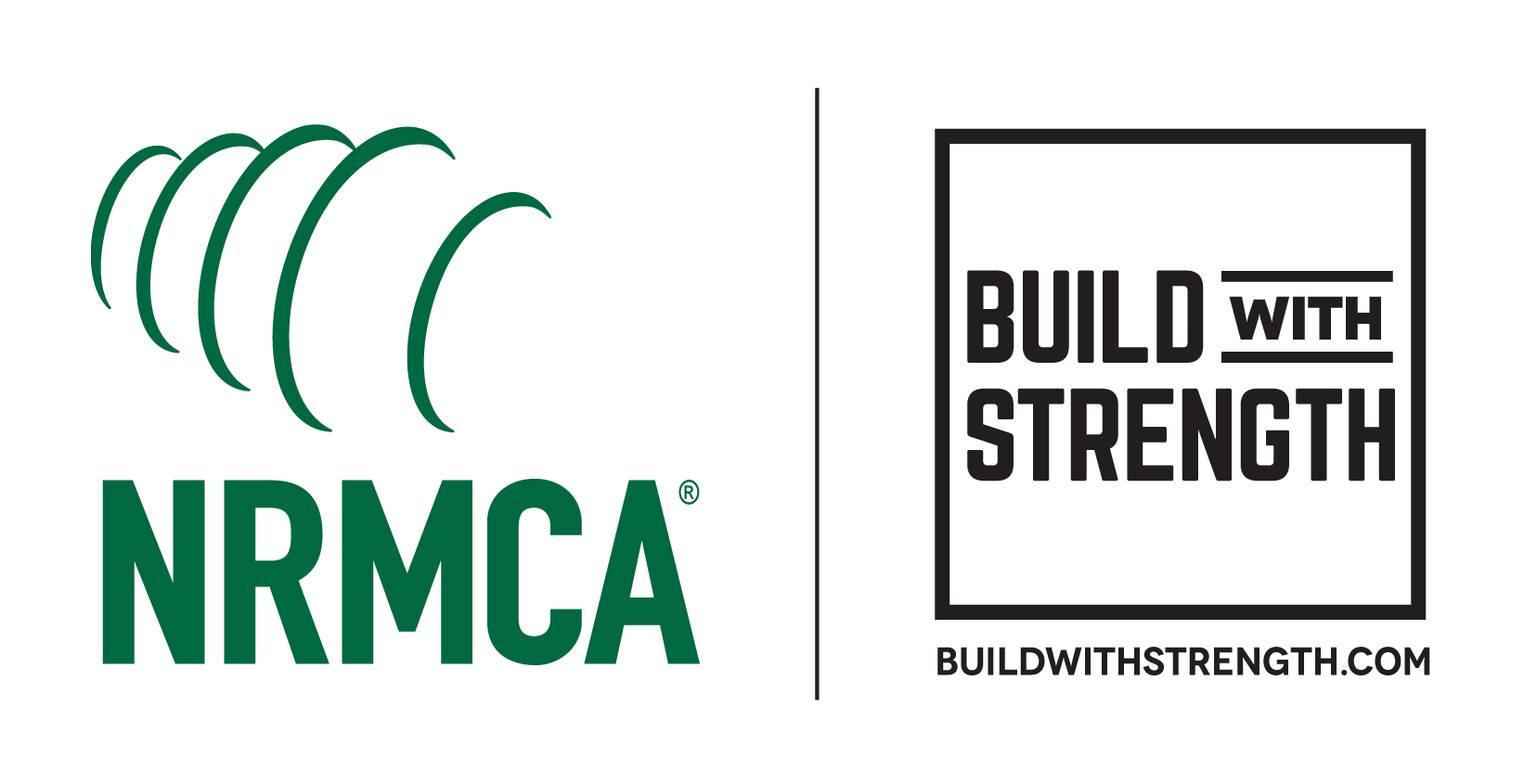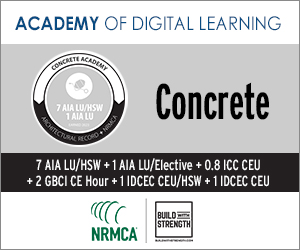Embracing Sustainable Architecture Through Creative Concrete Solutions
Learning Objectives:
- Describe different types of decorative concrete trends and treatments, including overlays, coloring techniques and finishes, and exposed aggregate.
- Discuss the growing popularity of decorative concrete and examine a range of project types that would benefit from decorative concrete solutions.
- Identify the aesthetic and performance strengths of decorative concrete and explore ways in which longevity and quality can be maintained.
- Explain how different types of decorative concrete can support a project’s sustainability goals.
This course is part of the Concrete Academy
This webinar is part of the Concrete Academy
Decorative concrete is not your parents’ drab, utilitarian concrete … but it is, without question, on the cutting edge of a new breed of concrete design and architecture. The plain, rough gray of traditional concrete has given way to low-maintenance, eco-friendly design solutions that offer strength, beauty, and versatility for a wide range of building types, both inside and out.
Concrete as a work of art? Not only is it possible, but these trends, including textures, stamps, and exposed aggregate, are gaining steam, offering architecture and design professionals an innovative and cost-effective way to transform concrete substrates into an aesthetic focal point. Through presentations by an expert panel, which will include project case studies, this webinar will explore a variety of decorative techniques, covering such topics as aesthetic and performance benefits, available and dynamic finishes, materials and methods, process and production, how architects dealt with the challenges of working with exposed and decorative concrete, as well as the designers’ vision, mock-ups and specs.
Susan England of LandDesign will present two exciting projects:
Lumen is the latest multifamily high-rise to grace Tysons, Virginia’s growing skyline. Located adjacent to the Greensboro MetroRail Station, Lumen is a true example of urban living, providing residents access to a collection of urban environments along the MetroRail. LandDesign was engaged from concept through construction and delivered a landscape design that blends the modern architectural style of the building with lush open spaces.
Surrounded by two major roadways, a public park lines the ground level of the development, inviting residents and pedestrians to gather and socialize. On multiple rooftop terrace levels, elevated planters, intricate paving and seating create the illusion of private nodes and nooks, allowing residents to explore and use the space in their own way.
A shallow profile between structural slab and finished floor elevations prevented the use of real unit pavers, and budget constraints made concrete more feasible. In order to still get a highly custom look that fit the building aesthetic and could provide a richness to the space, the team worked with a well-known building product manufacturer and the contractor to apply a complete custom surface and saw cut joint pattern that mimics natural stone pavers.
With its sole tenant, Discovery, consolidating its headquarters elsewhere, the building owner embarked on a major overhaul, reimagining the building as Inventa Towers to provide the community and tenants with an experience not available elsewhere in the market. LandDesign was engaged to help transform the property at the heart of downtown Silver Spring, Maryland, and major transit and vehicular access between Montgomery County and the District of Columbia.
For years, the building was encircled with an unsightly large black fence for controlled access. Today the site is open and outwardly facing as publicly accessible park space, serving as a much-needed connection from the Metro station to downtown, and to the larger park network that runs through the city. This new park amenity has been designed to restore connectivity while creating spaces to relax, gather and play.
While unit pavers were utilized in select areas of the project, budget constraints prevented the exclusive use of them. Needing a material that was refined enough to complement the reinvented building arrival court, yet durable enough to hold up to daily public use, the team developed a concrete treatment that checked all the boxes. Through a mock-up review process, a light surface retardant, or acid wash application was selected to expose a modest amount of the grey aggregate. Saw cut score joints carefully laid out to align with the major circulation patterns completed the look.
Frank Mrak and Donn Thompson, experts from the National Ready Mixed Concrete Association (NRMCA), will present “The Environmental Impacts of Building Materials – Comparing Concrete, Wood, and Steel.”
The impact of building materials on the environment continues to grow in importance within the construction industry. In addition to performance, budget and aesthetics, design professionals are now being asked to evaluate the environmental burdens of their design choices. Measuring the impacts of buildings, assemblies and products can be complex. Every design decision, from material and product selection to envelope design and construction can have an impact on the environment and the methods used to evaluate those decisions are still not widely understood. This presentation will address critical issues the design professional should consider when evaluating the environmental impacts of building materials to maximize performance and deliver lasting value.
The main takeaways are related to sustainability goals, focusing on:
- Recognizing how design decisions can affect environmental impacts of a buildings.
- Learning how the life cycle perspective when making design decisions can help create sustainable projects.
- Identifying how critical issues such as land use, human health, energy efficiency and greenhouse gas emissions can impact environmental performance.
- Understanding how life cycle assessment can play a role in evaluating environmental impacts of design decisions. At the end of the presentations, there will be time for a brief Q&A with the speakers.
At the end of the presentations, there will be time for a brief Q&A with the speakers.

Photo courtesy of Land Design
Renovation and repositioning of the former Discovery Channel building in downtown Silver Spring turned a former private space into a new drop-off and publicly accessible park connecting shopping to the Metro rail and bus station.

|
Susan England, is a Senior Associate and Studio Leader in LandDesign’s Alexandria, VA, office who works hard to immerse herself in the communities she works with. She engages with local organizations to remain informed and be a positive influence in shaping places people will use. Susan is responsible for the design, project management, and construction oversight for a variety of projects ranging from parks and playgrounds to streetscape and rooftop amenities for multi-block mixed use developments. |

|
Frank Mruk, FAIA, LEED AP, is an architect and innovation strategist. He is a senior director of building innovations at NRMCA and a past executive director of the NY Center for Strategic Innovation and the Boston Center for Smart Building Technology and past Vice President of Strategy at Morgan Stanley. Frank was educated at Pratt Institute, Pace University and at the University of Oxford. He has taught Architecture at the School of Visual Arts, the Rhode Island School of Design, Roger Williams University, the Parsons School of Design, New York University, and at NYIT where he served as associate dean for the School of Architecture and Design. Frank is a Fellow of the AIA and the Strategic Planning Society. He has served as president of AIA RI, CSI NY and ASP NY. |
|
|
Donn C. Thompson, AIA, LEED AP BD+C, is the Senior Director, Building Innovations for the National Ready Mixed Concrete Association (NRMCA). Based northwest of Chicago, he supports NRMCA’s Build with Strength program, demonstrating the first cost and long-term ownership advantages of ready mixed concrete building systems throughout eight Midwest states. |







